 Neutering is often thought to be the castration of male animals, but it’s actually the term for both spaying of females and castrations of males. In females, the ovaries and uterus are removed; in males, the testicles are removed.
Neutering is often thought to be the castration of male animals, but it’s actually the term for both spaying of females and castrations of males. In females, the ovaries and uterus are removed; in males, the testicles are removed.
The reason most people neuter their dog or cat is because it’s widely accepted as the humane and responsible thing to do to help control the pet population. In most developed areas, there is a social pressure to neuter.
There are other reasons, too, besides helping to prevent the killing of millions of homeless dogs and cats each year. Castration reduces aggression, spraying and other territorial behaviors, and wandering. Spaying of females reduces their susceptibility to certain reproductive disorders. When dogs and cats are kept intact (not neutered) their bodies are designed for natural reproductive cycles. In domestication, however, these natural cycles are not usually allowed. Regular house pets don’t breed enough, and animals used for breeding are bred too much. Both situations cause health problems – physical and emotional.
There is, however, some debate on whether it’s best to neuter or not. If you have doubts, research the issue and talk with a holistic veterinarian.
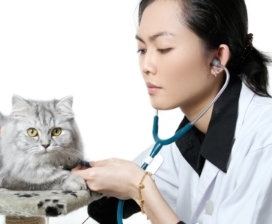 Another area of contention involves the age of the animal. At what age should your dog or cat be spayed or castrated? Some believe that an animal should be neutered after it reaches the age of sexual maturity or puberty. For females, this means six to eight months, for males, nine to twelve months.
Another area of contention involves the age of the animal. At what age should your dog or cat be spayed or castrated? Some believe that an animal should be neutered after it reaches the age of sexual maturity or puberty. For females, this means six to eight months, for males, nine to twelve months.
In his book, Dr. Pitcairn’s Complete Guide to Natural Health for Dogs and Cats, Dr. Richard Pitcairn advocates the following neutering schedule. He says that females should reach their first heat cycle, and male cats will be at the age when they develop strong smelling urine and will begin to spray. At this time, male dogs will also lift a leg to urinate and mark territory, mount other dogs, wander, fight, and become more aggressive. Waiting until this pubescent stage “ensures the least effect on the neuro-endocrine system and allows full development of a normal adult body shape.” Other experts are in agreement.
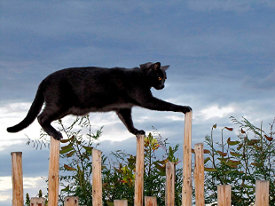 There is another faction, however, who believe it’s best not to wait until the dog or cat reaches sexual maturity. In her book, The Encyclopedia of Natural Pet Care, CJ Puotinen explains that veterinarians used to believe that pre-puberty castration increased a male’s susceptibility to urethral problems such as obstruction. She says that studies have shown this is not necessarily true. She also cites studies which indicated the risk of breast cancer was higher in females who were spayed after their first heat cycle.
There is another faction, however, who believe it’s best not to wait until the dog or cat reaches sexual maturity. In her book, The Encyclopedia of Natural Pet Care, CJ Puotinen explains that veterinarians used to believe that pre-puberty castration increased a male’s susceptibility to urethral problems such as obstruction. She says that studies have shown this is not necessarily true. She also cites studies which indicated the risk of breast cancer was higher in females who were spayed after their first heat cycle.
Many puppies and kittens are now neutered when they reach six to fourteen weeks old, particularly in shelters and breeding businesses. The shelters have some valid reasons.  They say that neutering as soon as possible limits unwanted pregnancies and genetic disorders, and it makes the pets more adoptable. This practice at shelters also ensures that the pets leaving the shelter won’t be used for breeding.
They say that neutering as soon as possible limits unwanted pregnancies and genetic disorders, and it makes the pets more adoptable. This practice at shelters also ensures that the pets leaving the shelter won’t be used for breeding.
Opponents to “pediatric neutering”, according to Puotinen, have concerns that there is an increased risk when using anesthesia on such young dogs and cats, and that the practice can cause “urinary incontinence, obesity, vaginal infections, dermatitis, growth and weight deficiencies, and behavioral changes.” She concludes by stating, “Although at least one study showed no significant difference between cats whose surgery took place at seven weeks and those who were operated on at seven months, many veterinarians believe there isn’t sufficient scientific data to determine whether early-age sterilization is completely free of long-term side effects.”
Again, the bottom line for you, 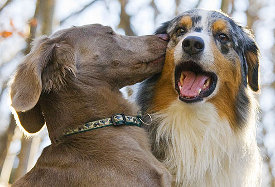 if you have questions, is to research the issue and discuss it with a holistic veterinarian.
if you have questions, is to research the issue and discuss it with a holistic veterinarian.
At any rate, if you feed a well-balanced and nutritious raw diet, you are building up your animal’s health, strength, and immune system. And robust health is beneficial before surgery at any age. For general tips regarding surgery, see Surgery. For reproductive system disorders, see that section. Neutered animals may have problems with their urinary tracts and incontinence when they age. See Urinary Tract Problems.
Herbal and Naturopathic Help
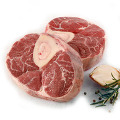 Every pet should be on a natural, well-balanced, raw meat diet. See the Diet section. In addition, a good multi-vitamin/mineral supplement is a good idea. Optimum nutrition is the best prevention against almost all diseases. Even something like female incontinence, which is partially attributed to eating commercial pet foods and partially attributed to a lack of hormones, can be staved off with a well-balanced, raw diet. This is because the liver and other hormone-producing glands can balance out the system of a healthy animal, compensating naturally for the decrease in sex hormones from spaying. CJ Puotinen states “the adrenal glands and liver take over the ovaries’ biological function by continuing to produce small amounts of estrogen until old age.”
Every pet should be on a natural, well-balanced, raw meat diet. See the Diet section. In addition, a good multi-vitamin/mineral supplement is a good idea. Optimum nutrition is the best prevention against almost all diseases. Even something like female incontinence, which is partially attributed to eating commercial pet foods and partially attributed to a lack of hormones, can be staved off with a well-balanced, raw diet. This is because the liver and other hormone-producing glands can balance out the system of a healthy animal, compensating naturally for the decrease in sex hormones from spaying. CJ Puotinen states “the adrenal glands and liver take over the ovaries’ biological function by continuing to produce small amounts of estrogen until old age.”
 CJ Puotinen and some other experts recommend giving a glandular supplement. She explains that these glandular supplements don’t supply the hormones that the glands produce, but they do have substances which your pet doesn’t get from other foods. These substances used to be consumed by your pet’s ancestors in the wild when natural prey was eaten.
CJ Puotinen and some other experts recommend giving a glandular supplement. She explains that these glandular supplements don’t supply the hormones that the glands produce, but they do have substances which your pet doesn’t get from other foods. These substances used to be consumed by your pet’s ancestors in the wild when natural prey was eaten.
When an animal is neutered, its body won’t be producing its natural sex hormones. These hormones regulate the production of other hormones like cortisone from the adrenal gland. Adrenal cortisone plays an important role in lymph gland antibody production, which is a vital part of your pet’s immune system. Proper nutrition and a multi-vitamin that includes pantothenic acid in its B-complex will help compensate. Licorice root is used to assist the adrenal gland. Talk to your holistic veterinarian, though, before dosing your pet yourself. An overdose of licorice root can cause serious problems.
Other herbs thought to help correct hormonal imbalances include Ashwagandha, ginseng, and schisandra.
 Fresh hops have been proven to have estrogenic effects and can therefore be used to help with female sex hormone regulation. Fresh hops, for the same reason, have also been used to subdue the sex drive of overly persistent males. Dried hops don’t have the same effect, but they do have sedative or calming properties.
Fresh hops have been proven to have estrogenic effects and can therefore be used to help with female sex hormone regulation. Fresh hops, for the same reason, have also been used to subdue the sex drive of overly persistent males. Dried hops don’t have the same effect, but they do have sedative or calming properties.
Chasteberry is good for female hormone issues because it stimulates the pituitary gland. It’s also known to help with overall kidney health. Dong quai is a well-known Chinese herb used to regulate hormone production and it’s good for the liver.
Oatstraw has estrogenic compounds, which may improve hormone regulation that has been impacted by spaying. Oatstraw may also help with incontinence, and it can be used for irritable bowels as well. 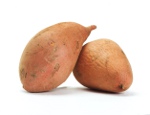 Wild yam is another tried and true favorite for hormone regulation. It has been used for many years in people because of its ability to help with the production of a number of hormones. It’s also used to support the spleen, kidneys, lungs, and, particularly, the liver. Wild yam creams have been sold to women for years as hormone replacement aids and as arthritis treatments. This same cream can also be used on your pets.
Wild yam is another tried and true favorite for hormone regulation. It has been used for many years in people because of its ability to help with the production of a number of hormones. It’s also used to support the spleen, kidneys, lungs, and, particularly, the liver. Wild yam creams have been sold to women for years as hormone replacement aids and as arthritis treatments. This same cream can also be used on your pets.